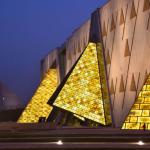After more than a century, Ghana’s Asante Kingdom has regained 130 royal artifacts looted during colonial wars—an emotional moment of justice, pride, and historical restoration for one of Africa’s greatest empires.
In a moment hailed as one of Africa’s most significant acts of cultural restitution, Britain and South Africa have returned more than 130 looted royal artifacts to Ghana’s Asante Kingdom. The reunion—more than a century in the making—brings back gold and bronze regalia once seized during colonial-era wars that devastated one of West Africa’s most influential kingdoms.
The artifacts were formally received on Sunday at the Manhyia Palace Museum by Asante King Otumfuo Osei Tutu II. The palace described the homecoming as a “powerful gesture of healing and historical justice.”
Among the treasures are gold weights, ceremonial drums, and regalia dating back as far as 160 years, each piece representing the spiritual, political, and artistic heart of the Asante civilization.
“These objects are not just art—they are part of the soul of our nation,” said museum director Ivor Agyeman-Duah, whose team coordinated the complex negotiations that led to the return.
The Long Road Home
The repatriation involved three primary sources. The Barbier-Muller Museum in Geneva contributed 110 artifacts collected by Josef Muller beginning in 1904. British art historian Hermione Waterfield, 86, personally returned 25 items from her private collection—including a 46-inch fontomfrom drum believed to have been seized during the 1900 siege of Kumasi. AngloGold Ashanti, the South African mining giant, voluntarily repatriated additional items that it had acquired through legitimate market purchases.
AngloGold’s Chief Corporate Affairs and Sustainability Officer, Stuart Bailey, said the decision reflected a corporate “commitment to historical justice and community partnership.”
Colonial Loot and the Anglo-Asante Wars
The dispersal dates back to the violent Anglo-Asante Wars of the 19th century. In 1874, British forces stormed Kumasi during the Sagrenti War, looting the royal palace and confiscating thousands of gold artifacts as indemnity.
Fifty thousand ounces of gold were exacted as punishment for Asante resistance, and royal treasures were later auctioned at Garrards in London. The theft fractured Asante cultural continuity and dispersed its artistic legacy across Western museums and private collections.
For decades, Asante leaders sought redress. Asantehene Opoku Ware II first petitioned Britain for restitution in 1974. Renewed efforts under Otumfuo Osei Tutu II, combined with a rising global reckoning over colonial plunder, led to breakthroughs in 2023 and 2024.
British institutions, still restricted by law from permanent restitution, agreed to loan 32 items under renewable three-year terms. Including recent returns, the Manhyia Palace Museum now holds 67 objects repatriated or loaned from foreign institutions.
A Collector’s Reckoning
Hermione Waterfield’s voluntary return marked one of the most personal acts in the restitution process. In a statement, she described her decision as a moral obligation: “These artifacts never truly belonged to me. They belong where their meaning was born.” Her contribution includes several ceremonial items inherited or purchased between 1967 and 1973.
Unfinished Justice
Despite this landmark moment, the restitution debate remains far from settled. The British Museum still retains 52 Asante pieces, barred from permanent return by U.K. heritage law. Critics argue that such “long-term loans” reinforce colonial ownership frameworks and undermine genuine restitution. The case echoes similar disputes over Nigeria’s Benin Bronzes and Greece’s Parthenon Marbles.
Pan-African Implications
The Asante success strengthens Africa’s broader campaign for heritage recovery. Cultural officials from Nigeria, Ethiopia, and Egypt have already cited the Ghanaian experience as a model for future negotiations.
Ghana’s Minister of Tourism, Arts and Culture, Ibrahim Mohammed Awal, called the repatriation “a turning point in how the world engages with Africa’s cultural identity—not as a museum subject, but as a sovereign contributor to global civilization.”
A Nation Reconnected
At the Manhyia Palace, thousands gathered to witness the artifacts’ unveiling—golden crowns, stools, and drums glinting under soft evening light. For the Asante people, it was more than a ceremony; it was the restoration of memory.
“These objects help us connect the past with the present,” Agyeman-Duah said. “They remind us of our ancestors’ genius in governance, goldwork, and design.”
After more than a century of separation, the Asante Kingdom’s treasures are finally home—silent witnesses of empire, resistance, and rebirth. They stand once again where they belong: in Kumasi, heart of the Asante world.
Leave a comment
Your email address will not be published. Required fields are marked *




